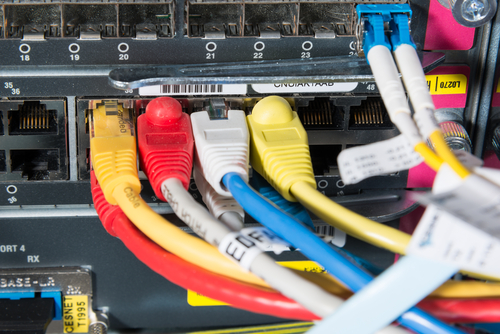 It's official: The IEEE has formed a study group to advance next-generation 400-Gbit/s Ethernet, with its chairman telling Slashdot that the standard could be ratified by 2017. So-called "pre-standard" products could appear as early as mid- to late 2016, said John D'Ambrosia, chair of the new IEEE 802.3 400Gbps Ethernet Study Group and a technology evangelist with Dell. The 400-Gbit technology was essentially a done deal, given a straw poll last September that found 61 of the 62 attendees voting to support 400 Gbits/s as the basis for the near-term “call for interest,” or CFI. Ethernet running at terabits speed could be the next step, D'Ambrosia said, following 400-Gbit technology and the aggregation of 400-Gbit ports. In fact, data collected by the IEEE seems to imply that we could be using 400-Gbit Ethernet technology sooner than later. A July 2012 report by the IEEE concluded that, if current trends continue, networks would need to support capacity requirements of 1 terabit per second in 2015 and 10 terabits per second by 2020. But that's only partially true: D'Ambrosia said that the operators of the London Olympics were already dealing with terabit demands on their network last year. "For them, 2015 was already here," he said. Global IP traffic will experience a fourfold increase from 20 exabytes per month in 2010 to 81 exabytes per month in 2015, a 32 percent CAGR, the IEEE predicted, based on reports from networking providers such as Cisco. Ironically, in 2006, when the current 100-Gbits/ transition was considered, there was debate on whether or not the additional bandwidth was even necessary. "This time around everybody recognizes that bandwidth is just exploding," D'Ambrosia added. How much so? "One of the things that caught us off-guard—we actually had to double-check—was that, based on current trends, by 2016 the number of mobile videos people will be watching will exceed wirelines.” Even though 100-Gbit Ethernet products are just coming to market, the transition between 100- and 400-Gbit Ethernet is being considered; link aggregation is one solution, although it only scales so far until "it becomes a cable management nightmare," D'Ambrosia said. It's possible that some manufacturers will begin marketing so-called "pre-standard" or "draft-standard" products. Within the 802.11 Wi-Fi market, for example, the practice is almost standard, so that manufacturers have launched products based on a draft standard that can be fine-tuned with a firmware update. If manufacturers do launch those products, D'Ambrosia suggested they could roll out in late 2016. What could 400-Gbits/s technology look like? We won't truly know until proposals begin to be submitted. But in September, networking provider Finisar hinted that a potential 400 Gb/s MAC/PCS ASIC could be fabricated in either 20- or 28-nm CMOS, using a 400-bit wide bus and a 1 GHz clock rate. There is a strong desire to reuse 802.3ba, 802.3bj, and 802.3bm technology building blocks, one Finisar executive said at the time. Actual product sales have been shown to lag far behind the technology, with buyers actually purchasing slower, cheaper networking technologies rather than investing in the future. From a specification standpoint, however, the work is officially under way. Image: kubais/Shutterstock.com
It's official: The IEEE has formed a study group to advance next-generation 400-Gbit/s Ethernet, with its chairman telling Slashdot that the standard could be ratified by 2017. So-called "pre-standard" products could appear as early as mid- to late 2016, said John D'Ambrosia, chair of the new IEEE 802.3 400Gbps Ethernet Study Group and a technology evangelist with Dell. The 400-Gbit technology was essentially a done deal, given a straw poll last September that found 61 of the 62 attendees voting to support 400 Gbits/s as the basis for the near-term “call for interest,” or CFI. Ethernet running at terabits speed could be the next step, D'Ambrosia said, following 400-Gbit technology and the aggregation of 400-Gbit ports. In fact, data collected by the IEEE seems to imply that we could be using 400-Gbit Ethernet technology sooner than later. A July 2012 report by the IEEE concluded that, if current trends continue, networks would need to support capacity requirements of 1 terabit per second in 2015 and 10 terabits per second by 2020. But that's only partially true: D'Ambrosia said that the operators of the London Olympics were already dealing with terabit demands on their network last year. "For them, 2015 was already here," he said. Global IP traffic will experience a fourfold increase from 20 exabytes per month in 2010 to 81 exabytes per month in 2015, a 32 percent CAGR, the IEEE predicted, based on reports from networking providers such as Cisco. Ironically, in 2006, when the current 100-Gbits/ transition was considered, there was debate on whether or not the additional bandwidth was even necessary. "This time around everybody recognizes that bandwidth is just exploding," D'Ambrosia added. How much so? "One of the things that caught us off-guard—we actually had to double-check—was that, based on current trends, by 2016 the number of mobile videos people will be watching will exceed wirelines.” Even though 100-Gbit Ethernet products are just coming to market, the transition between 100- and 400-Gbit Ethernet is being considered; link aggregation is one solution, although it only scales so far until "it becomes a cable management nightmare," D'Ambrosia said. It's possible that some manufacturers will begin marketing so-called "pre-standard" or "draft-standard" products. Within the 802.11 Wi-Fi market, for example, the practice is almost standard, so that manufacturers have launched products based on a draft standard that can be fine-tuned with a firmware update. If manufacturers do launch those products, D'Ambrosia suggested they could roll out in late 2016. What could 400-Gbits/s technology look like? We won't truly know until proposals begin to be submitted. But in September, networking provider Finisar hinted that a potential 400 Gb/s MAC/PCS ASIC could be fabricated in either 20- or 28-nm CMOS, using a 400-bit wide bus and a 1 GHz clock rate. There is a strong desire to reuse 802.3ba, 802.3bj, and 802.3bm technology building blocks, one Finisar executive said at the time. Actual product sales have been shown to lag far behind the technology, with buyers actually purchasing slower, cheaper networking technologies rather than investing in the future. From a specification standpoint, however, the work is officially under way. Image: kubais/Shutterstock.com


